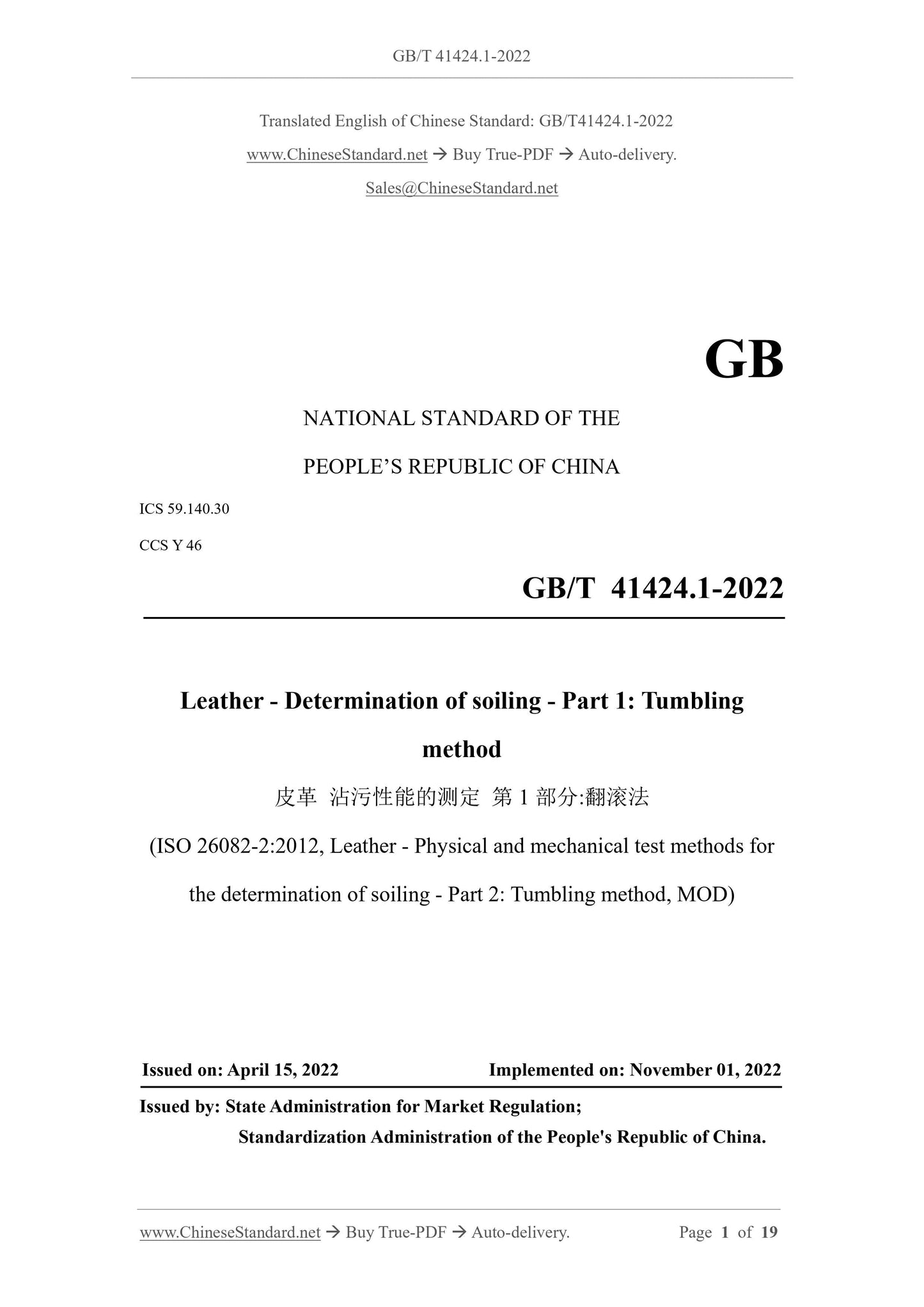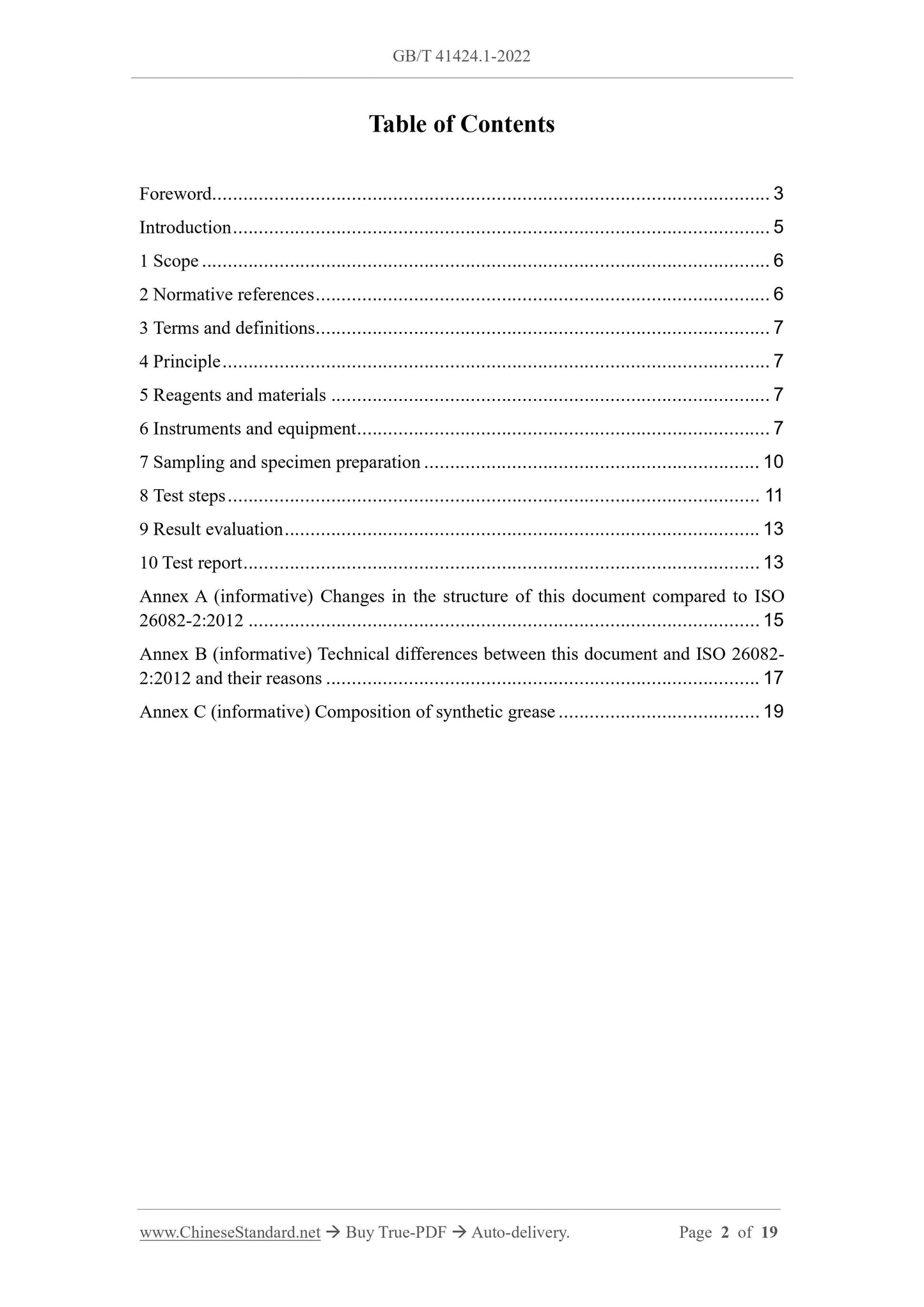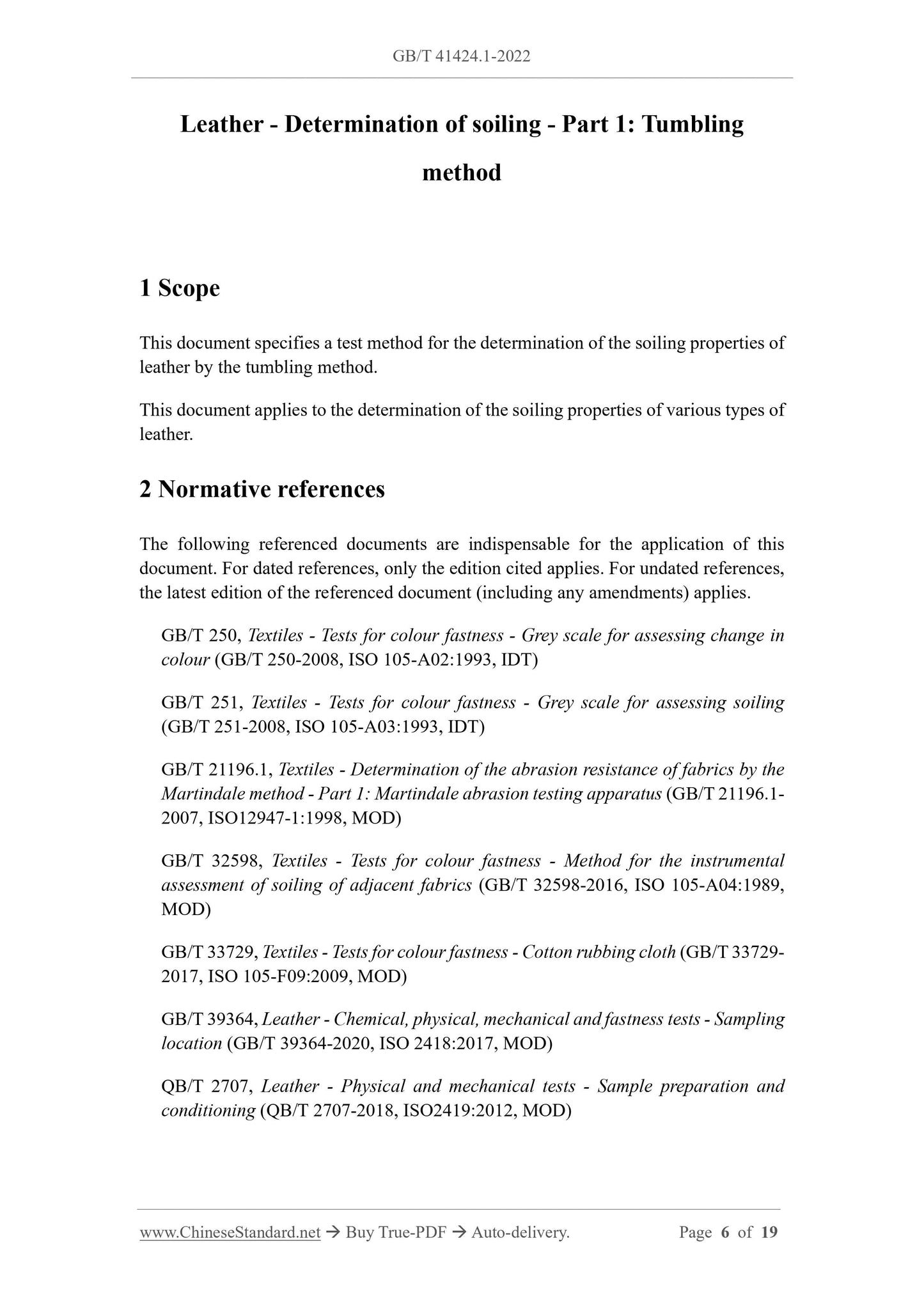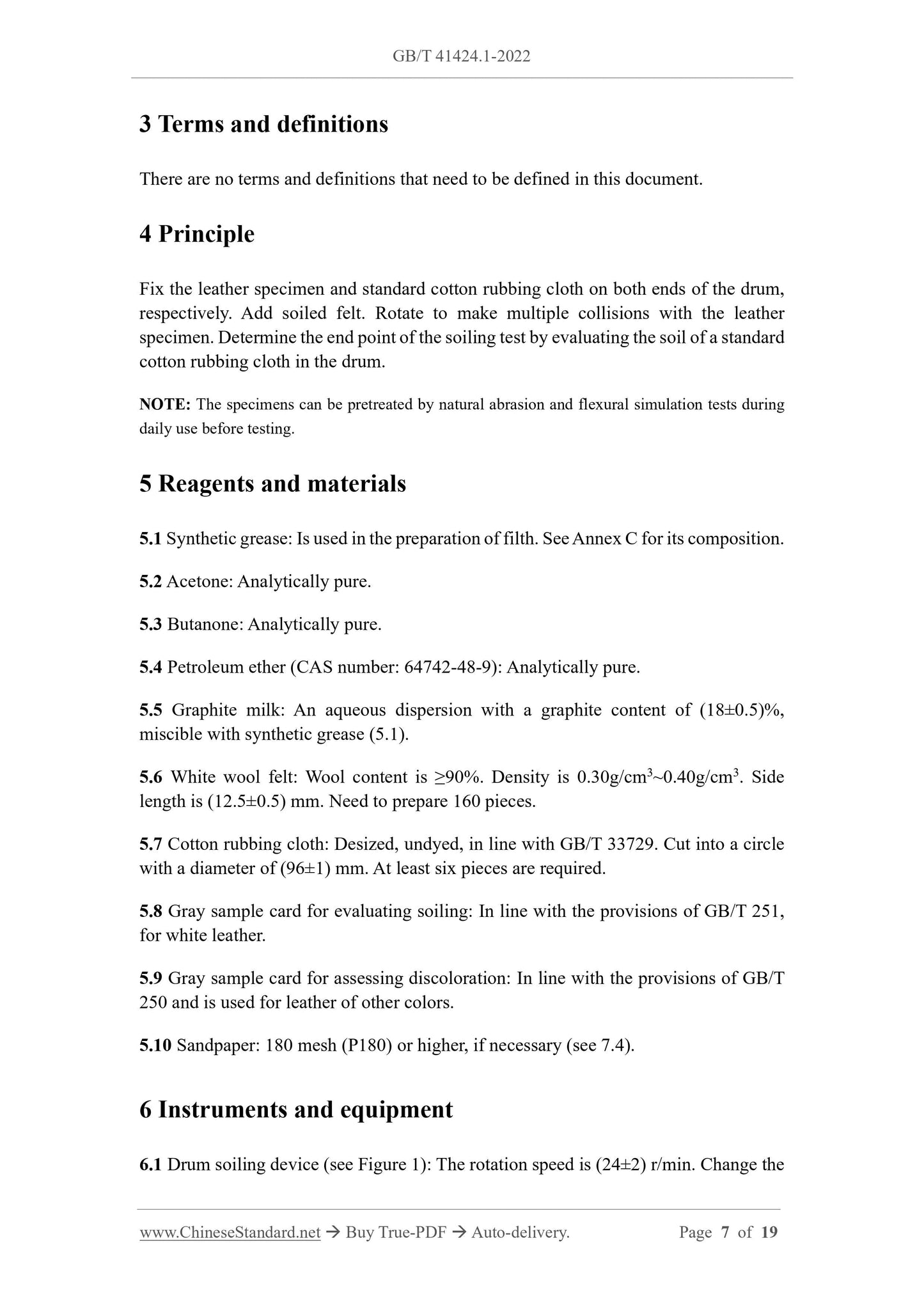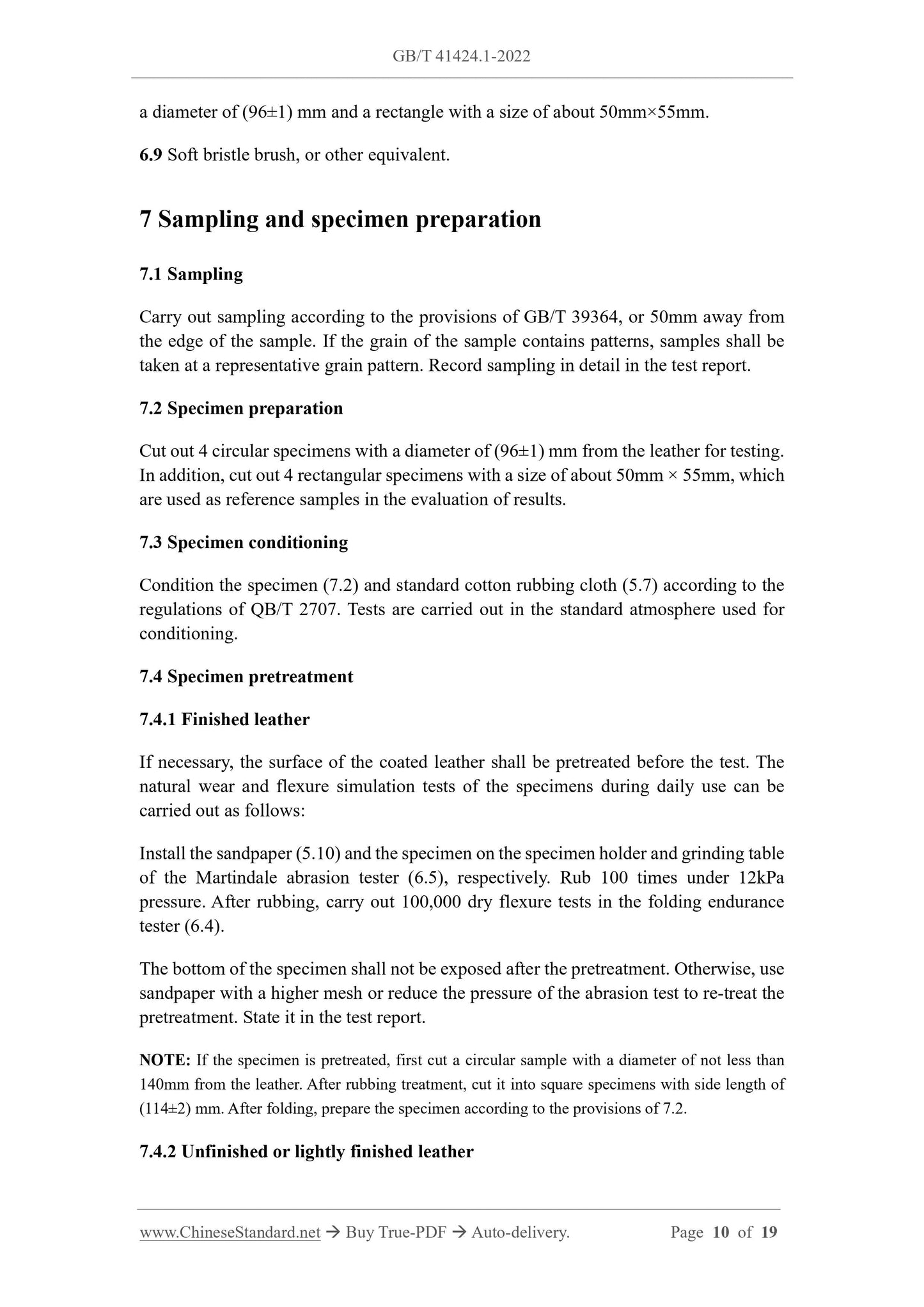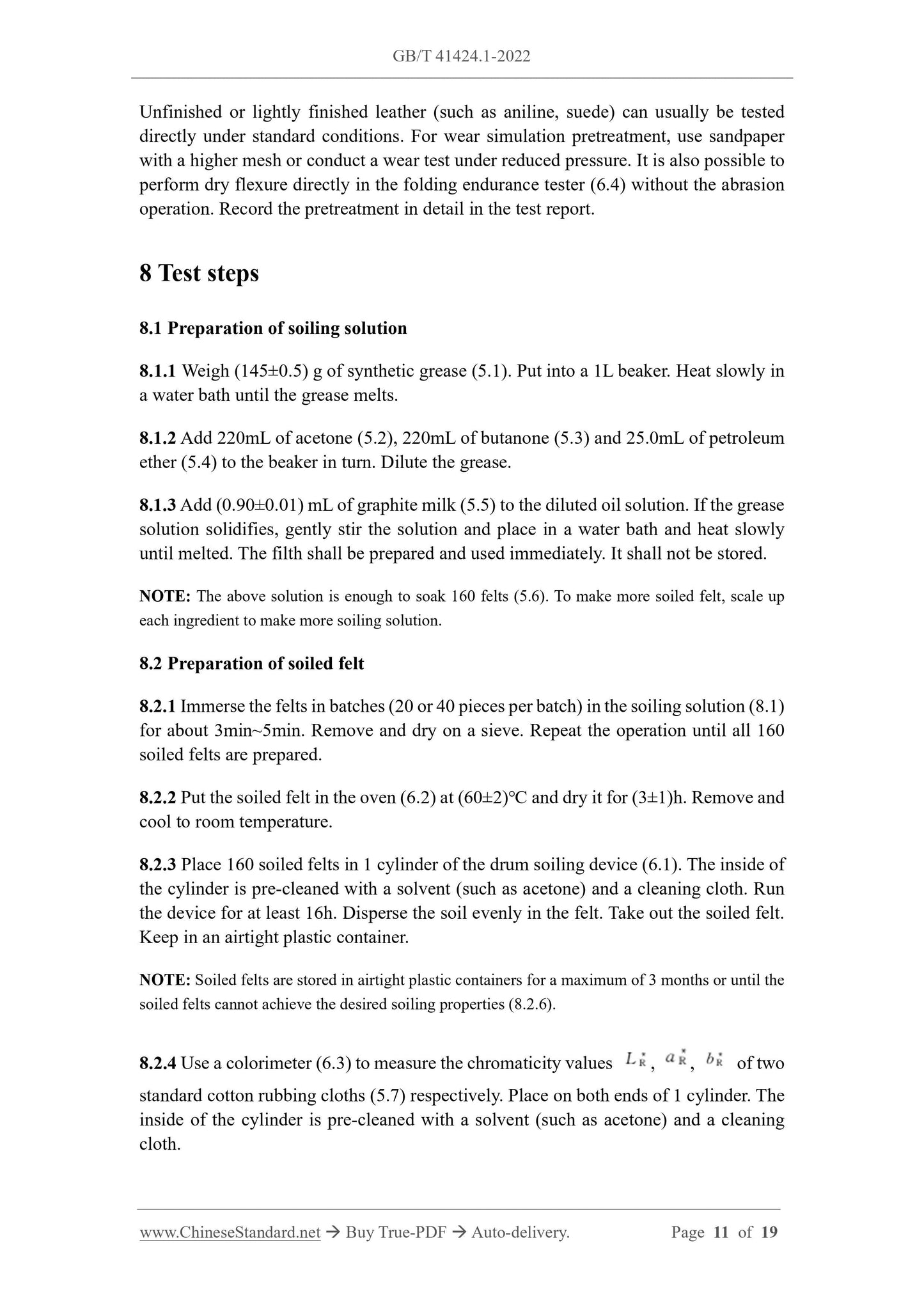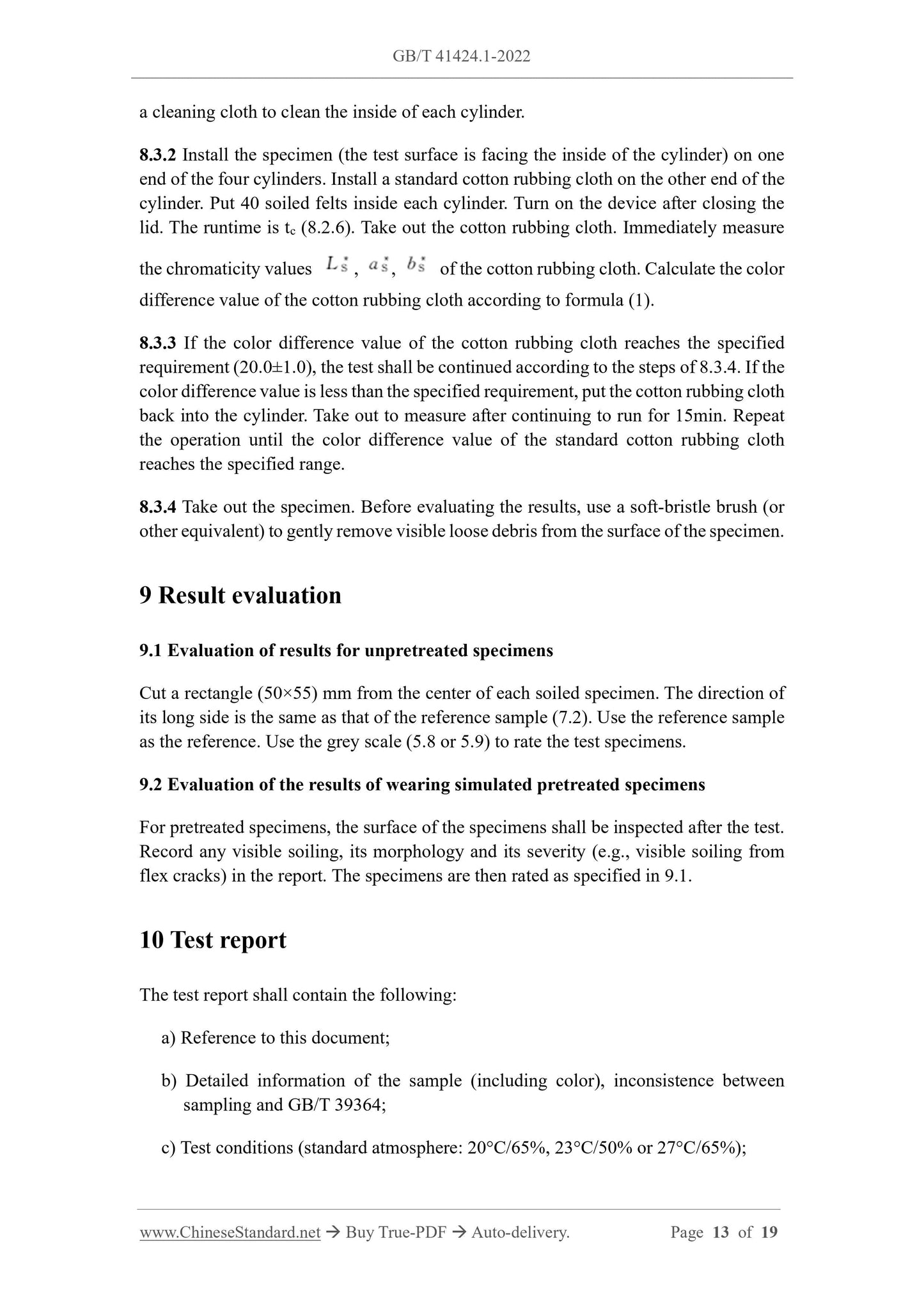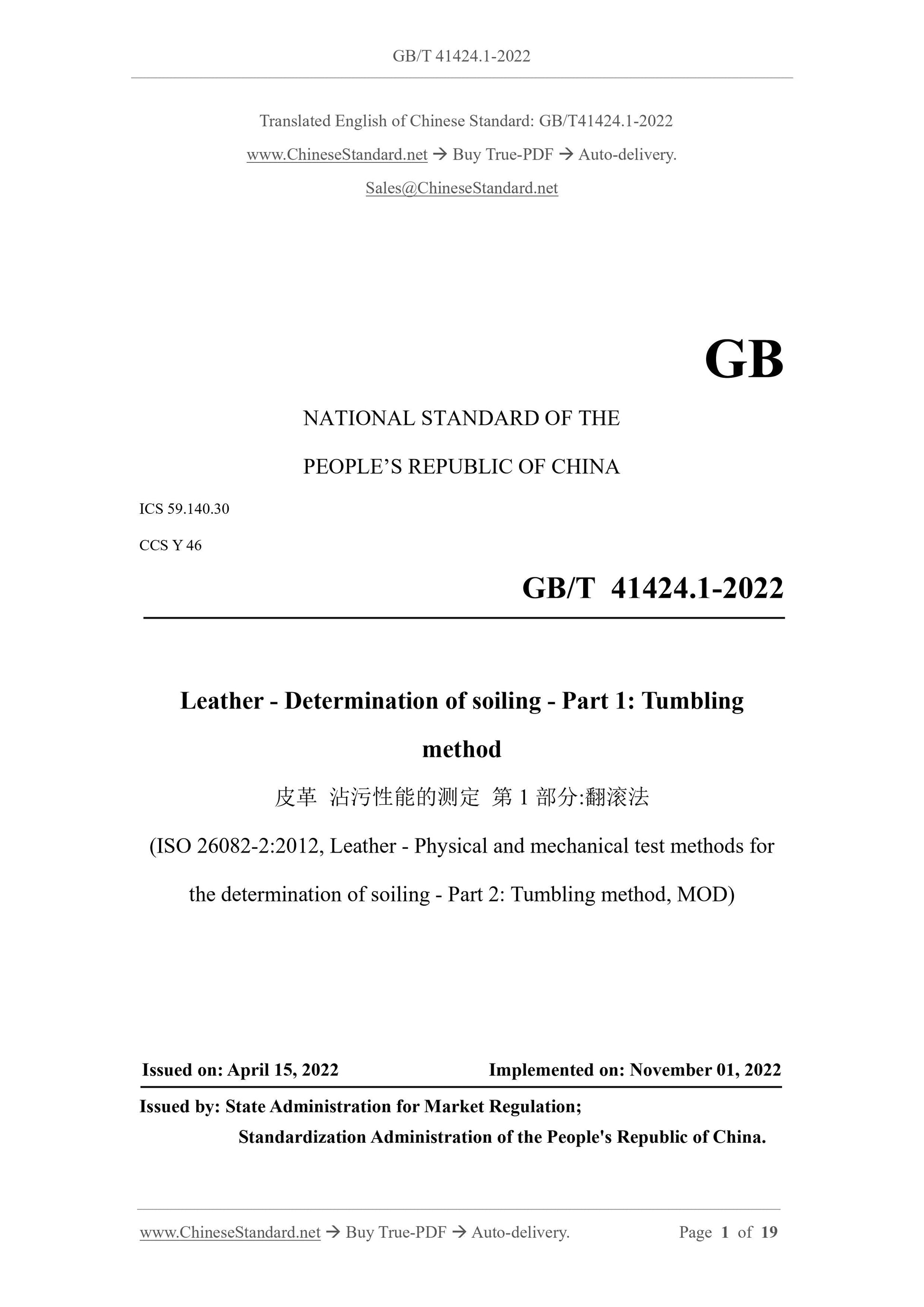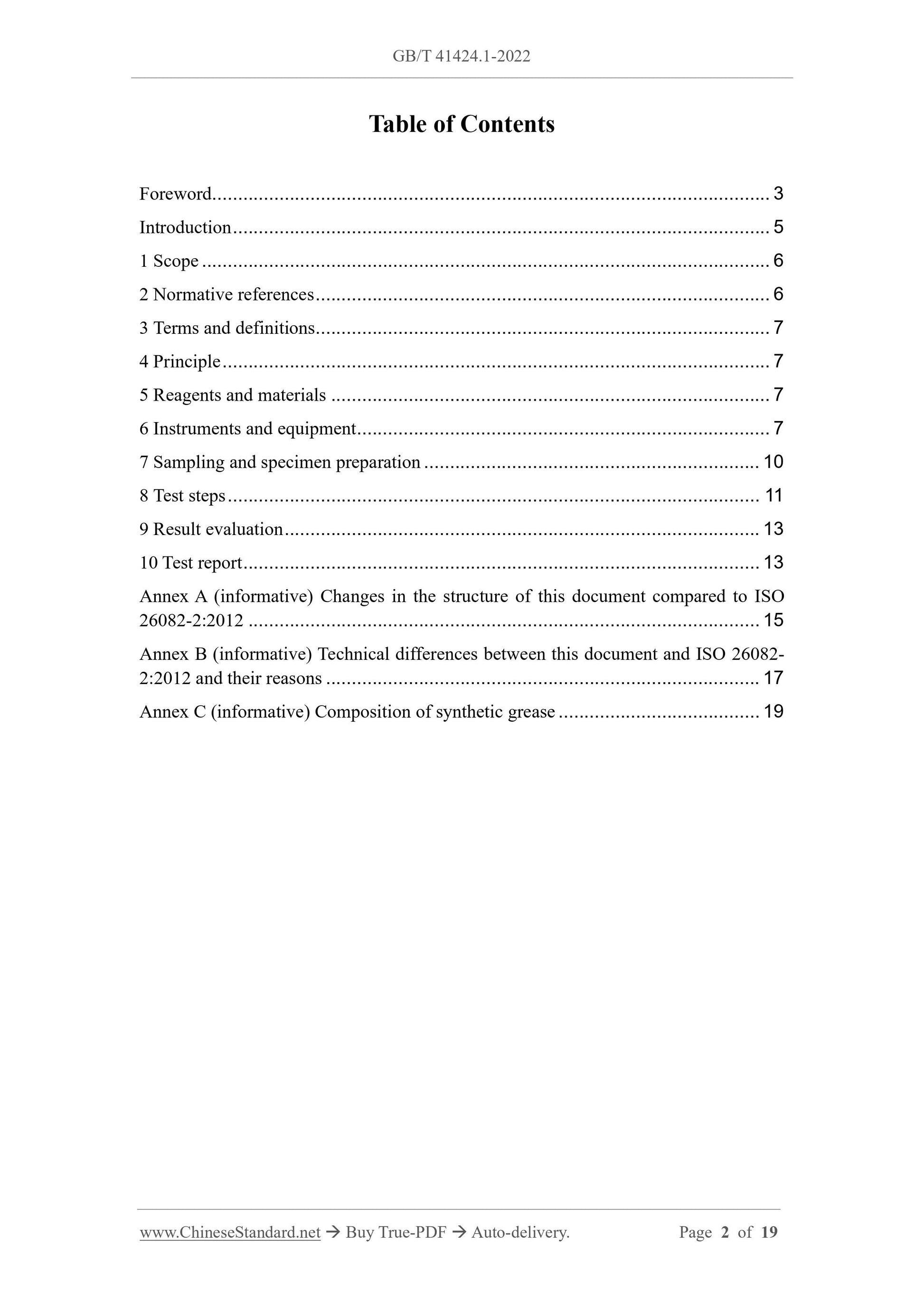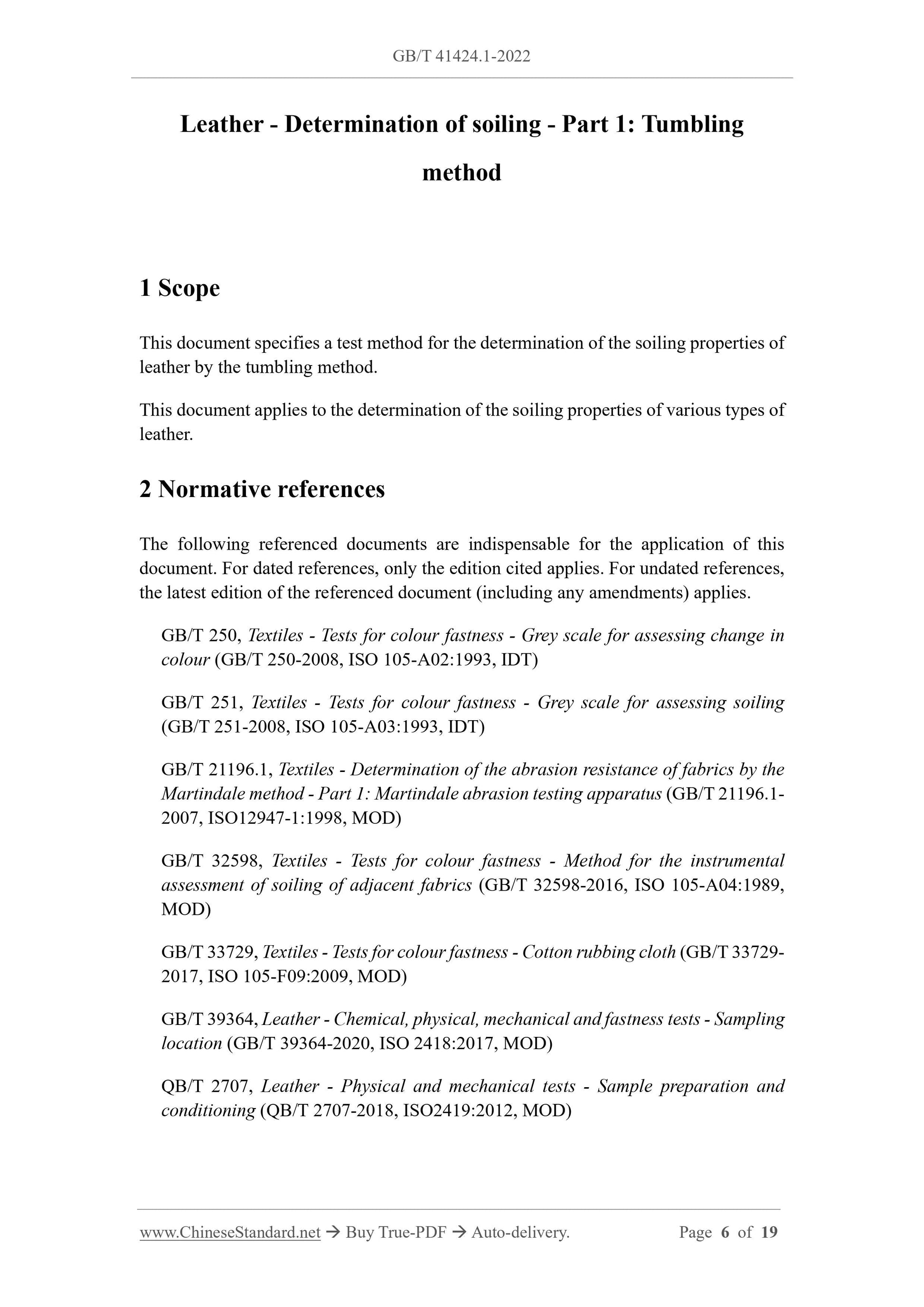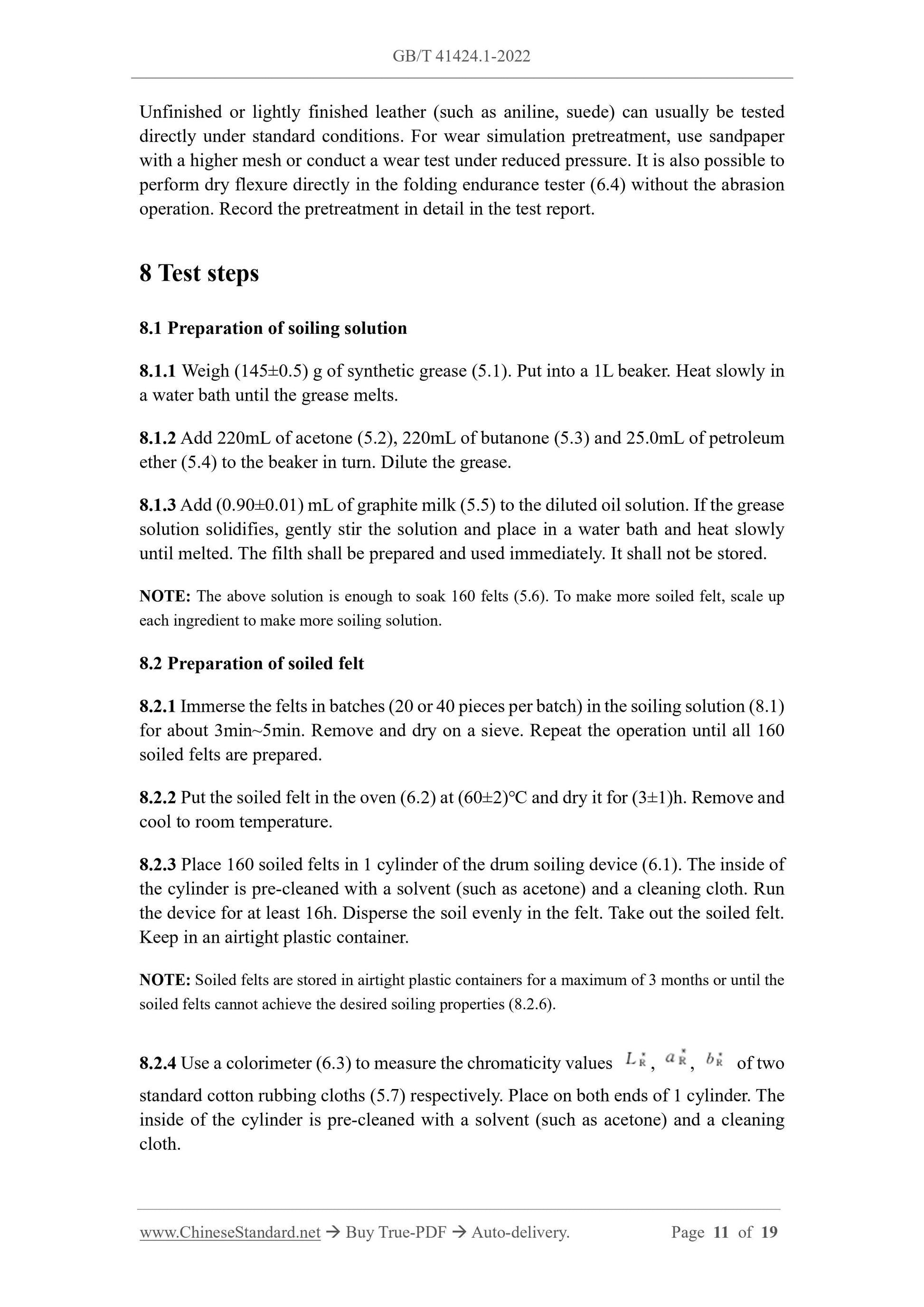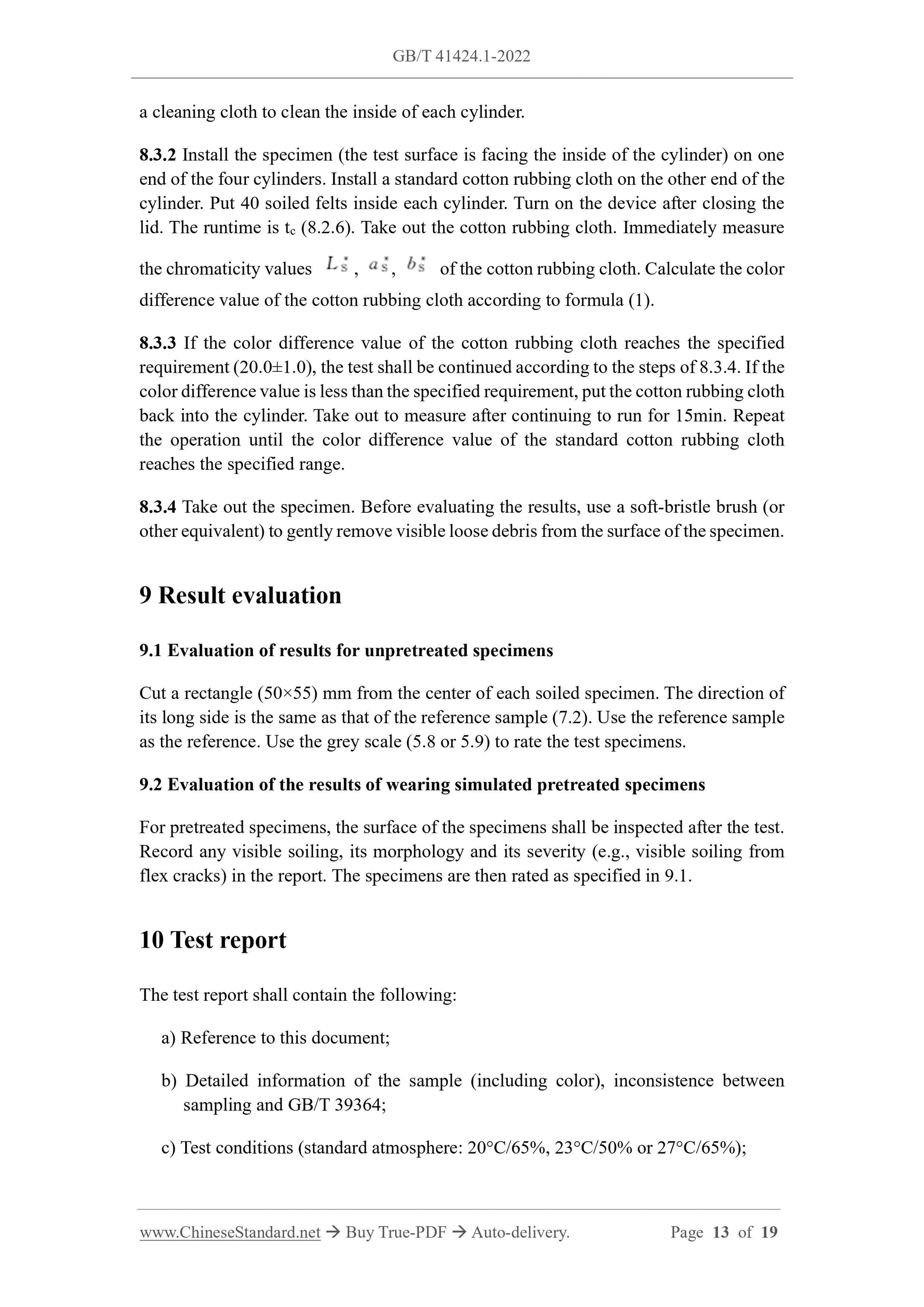1
/
of
7
PayPal, credit cards. Download editable-PDF & invoice in 1 second!
GB/T 41424.1-2022 English PDF (GBT41424.1-2022)
GB/T 41424.1-2022 English PDF (GBT41424.1-2022)
Regular price
$230.00 USD
Regular price
Sale price
$230.00 USD
Unit price
/
per
Shipping calculated at checkout.
Couldn't load pickup availability
Delivery: 3 seconds. Download true-PDF + Invoice.
Get QUOTATION in 1-minute: Click GB/T 41424.1-2022
Historical versions: GB/T 41424.1-2022
Preview True-PDF (Reload/Scroll if blank)
GB/T 41424.1-2022: Leather -- Determination of soiling -- Part 1:Tumbling method
GB/T 41424.1-2022
NATIONAL STANDARD OF THE
PEOPLE’S REPUBLIC OF CHINA
ICS 59.140.30
CCS Y 46
Leather - Determination of soiling - Part 1: Tumbling
method
(ISO 26082-2:2012, Leather - Physical and mechanical test methods for
the determination of soiling - Part 2: Tumbling method, MOD)
ISSUED ON: APRIL 15, 2022
IMPLEMENTED ON: NOVEMBER 01, 2022
Issued by: State Administration for Market Regulation;
Standardization Administration of the People's Republic of China.
Table of Contents
Foreword ... 3
Introduction ... 5
1 Scope ... 6
2 Normative references ... 6
3 Terms and definitions... 7
4 Principle ... 7
5 Reagents and materials ... 7
6 Instruments and equipment ... 7
7 Sampling and specimen preparation ... 10
8 Test steps ... 11
9 Result evaluation ... 13
10 Test report ... 13
Annex A (informative) Changes in the structure of this document compared to ISO
26082-2:2012 ... 15
Annex B (informative) Technical differences between this document and ISO 26082-
2:2012 and their reasons ... 17
Annex C (informative) Composition of synthetic grease ... 19
Leather - Determination of soiling - Part 1: Tumbling
method
1 Scope
This document specifies a test method for the determination of the soiling properties of
leather by the tumbling method.
This document applies to the determination of the soiling properties of various types of
leather.
2 Normative references
The following referenced documents are indispensable for the application of this
document. For dated references, only the edition cited applies. For undated references,
the latest edition of the referenced document (including any amendments) applies.
GB/T 250, Textiles - Tests for colour fastness - Grey scale for assessing change in
colour (GB/T 250-2008, ISO 105-A02:1993, IDT)
GB/T 251, Textiles - Tests for colour fastness - Grey scale for assessing soiling
(GB/T 251-2008, ISO 105-A03:1993, IDT)
GB/T 21196.1, Textiles - Determination of the abrasion resistance of fabrics by the
Martindale method - Part 1: Martindale abrasion testing apparatus (GB/T 21196.1-
2007, ISO12947-1:1998, MOD)
GB/T 32598, Textiles - Tests for colour fastness - Method for the instrumental
assessment of soiling of adjacent fabrics (GB/T 32598-2016, ISO 105-A04:1989,
MOD)
GB/T 33729, Textiles - Tests for colour fastness - Cotton rubbing cloth (GB/T 33729-
2017, ISO 105-F09:2009, MOD)
GB/T 39364, Leather - Chemical, physical, mechanical and fastness tests - Sampling
location (GB/T 39364-2020, ISO 2418:2017, MOD)
QB/T 2707, Leather - Physical and mechanical tests - Sample preparation and
conditioning (QB/T 2707-2018, ISO2419:2012, MOD)
3 Terms and definitions
There are no terms and definitions that need to be defined in this document.
4 Principle
Fix the leather specimen and standard cotton rubbing cloth on both ends of the drum,
respectively. Add soiled felt. Rotate to make multiple collisions with the leather
specimen. Determine the end point of the soiling test by evaluating the soil of a standard
cotton rubbing cloth in the drum.
NOTE: The specimens can be pretreated by natural abrasion and flexural simulation tests during
daily use before testing.
5 Reagents and materials
5.1 Synthetic grease: Is used in the preparation of filth. See Annex C for its composition.
5.2 Acetone: Analytically pure.
5.3 Butanone: Analytically pure.
5.4 Petroleum ether (CAS number: 64742-48-9): Analytically pure.
5.5 Graphite milk: An aqueous dispersion with a graphite content of (18±0.5)%,
miscible with synthetic grease (5.1).
5.6 White wool felt: Wool content is ≥90%. Density is 0.30g/cm3~0.40g/cm3. Side
length is (12.5±0.5) mm. Need to prepare 160 pieces.
5.7 Cotton rubbing cloth: Desized, undyed, in line with GB/T 33729. Cut into a circle
with a diameter of (96±1) mm. At least six pieces are required.
5.8 Gray sample card for evaluating soiling: In line with the provisions of GB/T 251,
for white leather.
5.9 Gray sample card for assessing discoloration: In line with the provisions of GB/T
250 and is used for leather of other colors.
5.10 Sandpaper: 180 mesh (P180) or higher, if necessary (see 7.4).
6 Instruments and equipment
6.1 Drum soiling device (see Figure 1): The rotation speed is (24±2) r/min. Change the
a diameter of (96±1) mm and a rectangle with a size of about 50mm×55mm.
6.9 Soft bristle brush, or other equivalent.
7 Sampling and specimen preparation
7.1 Sampling
Carry out sampling according to the provisions of GB/T 39364, or 50mm away from
the edge of the sample. If the grain of the sample contains patterns, samples shall be
taken at a representative grain pattern. Record sampling in detail in the test report.
7.2 Specimen preparation
Cut out 4 circular specimens with a diameter of (96±1) mm from the leather for testing.
In addition, cut out 4 rectangular specimens with a size of about 50mm × 55mm, which
are used as reference samples in the evaluation of results.
7.3 Specimen conditioning
Condition the specimen (7.2) and standard cotton rubbing cloth (5.7) according to the
regulations of QB/T 2707. Tests are carried out in the standard atmosphere used for
conditioning.
7.4 Specimen pretreatment
7.4.1 Finished leather
If necessary, the surface of the coated leather shall be pretreated before the test. The
natural wear and flexure simulation tests of the specimens during daily use can be
carried out as follows:
Install the sandpaper (5.10) and the specimen on the specimen holder and grinding table
of the Martindale abrasion tester (6.5), respectively. Rub 100 times under 12kPa
pressure. After rubbing, carry out 100,000 dry flexure tests in the folding endurance
tester (6.4).
The bottom of the specimen shall not be exposed after the pretreatment. Otherwise, use
sandpaper with a higher mesh or reduce the pressure of the abrasion test to re-treat the
pretreatment. State it in the test report.
NOTE: If the specimen is pretreated, first cut a circular sample with a diameter of not less than
140mm from the leather. After rubbing treatment, cut it into square specimens with side length of
(114±2) mm. After folding, prepare the specimen according to the provisions of 7.2.
7.4.2 Unfinished or lightly finished leather
Unfinished or lightly finished leather (such as aniline, suede) can usually be tested
directly under standard conditions. For wear simulation pretreatment, use sandpaper
with a higher mesh or conduct a wear test under reduced pressure. It is also possible to
perform dry flexure directly in the folding endurance tester (6.4) without the abrasion
operation. Record the pretreatment in detail in the test report.
8 Test steps
8.1 Preparation of soiling solution
8.1.1 Weigh (145±0.5) g of synthetic grease (5.1). Put into a 1L beaker. Heat slowly in
a water bath until the grease melts.
8.1.2 Add 220mL of acetone (5.2), 220mL of butanone (5.3) and 25.0mL of petroleum
ether (5.4) to the beaker in turn. Dilute the grease.
8.1.3 Add (0.90±0.01) mL of graphite milk (5.5) to the diluted oil solution. If the grease
solution solidifies, gently stir the solution and place in a water bath and heat slowly
until melted. The filth shall be prepared and used immediately. It shall not be stored.
NOTE: The above solution is enough to soak 160 felts (5.6). To make more soiled felt, scale up
each ingredient to make more soiling solution.
8.2 Preparation of soiled felt
8.2.1 Immerse the felts ...
Get QUOTATION in 1-minute: Click GB/T 41424.1-2022
Historical versions: GB/T 41424.1-2022
Preview True-PDF (Reload/Scroll if blank)
GB/T 41424.1-2022: Leather -- Determination of soiling -- Part 1:Tumbling method
GB/T 41424.1-2022
NATIONAL STANDARD OF THE
PEOPLE’S REPUBLIC OF CHINA
ICS 59.140.30
CCS Y 46
Leather - Determination of soiling - Part 1: Tumbling
method
(ISO 26082-2:2012, Leather - Physical and mechanical test methods for
the determination of soiling - Part 2: Tumbling method, MOD)
ISSUED ON: APRIL 15, 2022
IMPLEMENTED ON: NOVEMBER 01, 2022
Issued by: State Administration for Market Regulation;
Standardization Administration of the People's Republic of China.
Table of Contents
Foreword ... 3
Introduction ... 5
1 Scope ... 6
2 Normative references ... 6
3 Terms and definitions... 7
4 Principle ... 7
5 Reagents and materials ... 7
6 Instruments and equipment ... 7
7 Sampling and specimen preparation ... 10
8 Test steps ... 11
9 Result evaluation ... 13
10 Test report ... 13
Annex A (informative) Changes in the structure of this document compared to ISO
26082-2:2012 ... 15
Annex B (informative) Technical differences between this document and ISO 26082-
2:2012 and their reasons ... 17
Annex C (informative) Composition of synthetic grease ... 19
Leather - Determination of soiling - Part 1: Tumbling
method
1 Scope
This document specifies a test method for the determination of the soiling properties of
leather by the tumbling method.
This document applies to the determination of the soiling properties of various types of
leather.
2 Normative references
The following referenced documents are indispensable for the application of this
document. For dated references, only the edition cited applies. For undated references,
the latest edition of the referenced document (including any amendments) applies.
GB/T 250, Textiles - Tests for colour fastness - Grey scale for assessing change in
colour (GB/T 250-2008, ISO 105-A02:1993, IDT)
GB/T 251, Textiles - Tests for colour fastness - Grey scale for assessing soiling
(GB/T 251-2008, ISO 105-A03:1993, IDT)
GB/T 21196.1, Textiles - Determination of the abrasion resistance of fabrics by the
Martindale method - Part 1: Martindale abrasion testing apparatus (GB/T 21196.1-
2007, ISO12947-1:1998, MOD)
GB/T 32598, Textiles - Tests for colour fastness - Method for the instrumental
assessment of soiling of adjacent fabrics (GB/T 32598-2016, ISO 105-A04:1989,
MOD)
GB/T 33729, Textiles - Tests for colour fastness - Cotton rubbing cloth (GB/T 33729-
2017, ISO 105-F09:2009, MOD)
GB/T 39364, Leather - Chemical, physical, mechanical and fastness tests - Sampling
location (GB/T 39364-2020, ISO 2418:2017, MOD)
QB/T 2707, Leather - Physical and mechanical tests - Sample preparation and
conditioning (QB/T 2707-2018, ISO2419:2012, MOD)
3 Terms and definitions
There are no terms and definitions that need to be defined in this document.
4 Principle
Fix the leather specimen and standard cotton rubbing cloth on both ends of the drum,
respectively. Add soiled felt. Rotate to make multiple collisions with the leather
specimen. Determine the end point of the soiling test by evaluating the soil of a standard
cotton rubbing cloth in the drum.
NOTE: The specimens can be pretreated by natural abrasion and flexural simulation tests during
daily use before testing.
5 Reagents and materials
5.1 Synthetic grease: Is used in the preparation of filth. See Annex C for its composition.
5.2 Acetone: Analytically pure.
5.3 Butanone: Analytically pure.
5.4 Petroleum ether (CAS number: 64742-48-9): Analytically pure.
5.5 Graphite milk: An aqueous dispersion with a graphite content of (18±0.5)%,
miscible with synthetic grease (5.1).
5.6 White wool felt: Wool content is ≥90%. Density is 0.30g/cm3~0.40g/cm3. Side
length is (12.5±0.5) mm. Need to prepare 160 pieces.
5.7 Cotton rubbing cloth: Desized, undyed, in line with GB/T 33729. Cut into a circle
with a diameter of (96±1) mm. At least six pieces are required.
5.8 Gray sample card for evaluating soiling: In line with the provisions of GB/T 251,
for white leather.
5.9 Gray sample card for assessing discoloration: In line with the provisions of GB/T
250 and is used for leather of other colors.
5.10 Sandpaper: 180 mesh (P180) or higher, if necessary (see 7.4).
6 Instruments and equipment
6.1 Drum soiling device (see Figure 1): The rotation speed is (24±2) r/min. Change the
a diameter of (96±1) mm and a rectangle with a size of about 50mm×55mm.
6.9 Soft bristle brush, or other equivalent.
7 Sampling and specimen preparation
7.1 Sampling
Carry out sampling according to the provisions of GB/T 39364, or 50mm away from
the edge of the sample. If the grain of the sample contains patterns, samples shall be
taken at a representative grain pattern. Record sampling in detail in the test report.
7.2 Specimen preparation
Cut out 4 circular specimens with a diameter of (96±1) mm from the leather for testing.
In addition, cut out 4 rectangular specimens with a size of about 50mm × 55mm, which
are used as reference samples in the evaluation of results.
7.3 Specimen conditioning
Condition the specimen (7.2) and standard cotton rubbing cloth (5.7) according to the
regulations of QB/T 2707. Tests are carried out in the standard atmosphere used for
conditioning.
7.4 Specimen pretreatment
7.4.1 Finished leather
If necessary, the surface of the coated leather shall be pretreated before the test. The
natural wear and flexure simulation tests of the specimens during daily use can be
carried out as follows:
Install the sandpaper (5.10) and the specimen on the specimen holder and grinding table
of the Martindale abrasion tester (6.5), respectively. Rub 100 times under 12kPa
pressure. After rubbing, carry out 100,000 dry flexure tests in the folding endurance
tester (6.4).
The bottom of the specimen shall not be exposed after the pretreatment. Otherwise, use
sandpaper with a higher mesh or reduce the pressure of the abrasion test to re-treat the
pretreatment. State it in the test report.
NOTE: If the specimen is pretreated, first cut a circular sample with a diameter of not less than
140mm from the leather. After rubbing treatment, cut it into square specimens with side length of
(114±2) mm. After folding, prepare the specimen according to the provisions of 7.2.
7.4.2 Unfinished or lightly finished leather
Unfinished or lightly finished leather (such as aniline, suede) can usually be tested
directly under standard conditions. For wear simulation pretreatment, use sandpaper
with a higher mesh or conduct a wear test under reduced pressure. It is also possible to
perform dry flexure directly in the folding endurance tester (6.4) without the abrasion
operation. Record the pretreatment in detail in the test report.
8 Test steps
8.1 Preparation of soiling solution
8.1.1 Weigh (145±0.5) g of synthetic grease (5.1). Put into a 1L beaker. Heat slowly in
a water bath until the grease melts.
8.1.2 Add 220mL of acetone (5.2), 220mL of butanone (5.3) and 25.0mL of petroleum
ether (5.4) to the beaker in turn. Dilute the grease.
8.1.3 Add (0.90±0.01) mL of graphite milk (5.5) to the diluted oil solution. If the grease
solution solidifies, gently stir the solution and place in a water bath and heat slowly
until melted. The filth shall be prepared and used immediately. It shall not be stored.
NOTE: The above solution is enough to soak 160 felts (5.6). To make more soiled felt, scale up
each ingredient to make more soiling solution.
8.2 Preparation of soiled felt
8.2.1 Immerse the felts ...
Share
